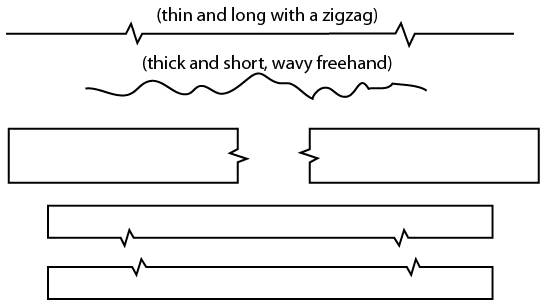2.1: Estilos y tipos de línea
- Page ID
- 153614
Describir líneas, letras y dimensionamiento en dibujos
El propósito de los dibujos de ingeniería es transmitir hechos objetivos, mientras que los dibujos artísticos transmiten emoción o sensibilidad artística de alguna manera.
Los dibujos y bocetos de ingeniería necesitan mostrar simplicidad y uniformidad, y deben ejecutarse con rapidez. El dibujo de ingeniería ha evolucionado hasta convertirse en un lenguaje que utiliza un amplio conjunto de convenciones para transmitir información de manera muy precisa, con muy poca ambigüedad.
La estandarización también es muy importante, ya que ayuda a la internacionalización; es decir, personas de diferentes países que hablan diferentes idiomas pueden leer el mismo dibujo de ingeniería e interpretarlo de la misma manera. Para ello, los dibujos deben estar lo más libres de notas y abreviaturas como sea posible para que el significado se transmita gráficamente.
Las líneas estándar se han desarrollado para que cada dibujo o boceto transmita el mismo significado a todos. Para transmitir ese significado, las líneas utilizadas en los dibujos técnicos tienen tanto un patrón definido como un grosor definido. Algunas líneas están completas y otras están rotas. Algunas líneas son gruesas y otras delgadas. Una línea visible, por ejemplo, se utiliza para mostrar los bordes (o “contorno”) de un objeto y para que destaque para facilitar su lectura. Esta línea se hace gruesa y oscura. Por otro lado, una línea central, que localiza el centro preciso de un agujero o eje, se dibuja delgada y se realiza con guiones largos y cortos. Esto hace que sea fácilmente distinguible de la línea visible.
Cuando dibujes, usa un lápiz bastante afilado del grado correcto e intenta mantener una presión uniforme y consistente para que sea más fácil producir líneas aceptables (Figura 1). Estudiar los grosores de línea (o “pesos de línea”) mostrados en la Figura 2 y practicar su elaboración.

- Grado de plomo y uso
- Pesos de líneas

- Líneas de objeto

- Líneas ocultas

- Líneas centrales

- Cota y líneas de referencia

- Lineas lideres

- Líneas fantasma

- Líneas de plano de corte

- Líneas de sección combinadas con líneas de plano de corte

- Línea de rotura




Líneas rizadas para abreviar un tramo más largo de tubería.

